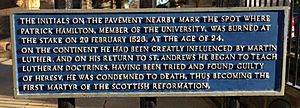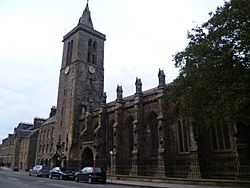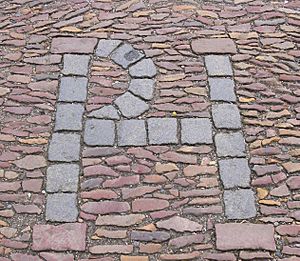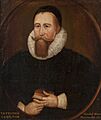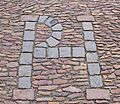Patrick Hamilton (martyr) facts for kids
Quick facts for kids
Patrick Hamilton
|
|
|---|---|
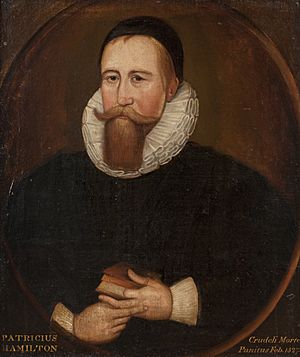
Patrick Hamilton by John Scougal, c. 1645-1730. This is the only known portrait of the martyr.
|
|
| Born | c. 1504 |
| Died | 29 February 1528 |
| Occupation | churchman and Reformer |

Patrick Hamilton (born around 1504 – died 29 February 1528) was an important Scottish churchman. He was one of the very first people in Scotland to support the ideas of the Protestant Reformation. This was a big movement that changed how people practiced Christianity in Europe.
Patrick traveled to other countries in Europe. There, he met many important thinkers who were part of the Reformation. When he came back to Scotland, he started sharing these new ideas. Because of his beliefs, he was put on trial by Archbishop James Beaton. He was found guilty of going against the church's teachings and was sadly burned at the stake in St Andrews.
Contents
Early Life and Studies
Patrick Hamilton was born around 1504. He was the second son of Sir Patrick Hamilton of Kincavil and Catherine Stewart. His mother was the daughter of Alexander Stewart, 1st Duke of Albany. Patrick was likely born near Stanehouse in Lanarkshire. He probably went to school in Linlithgow.
In 1517, when he was still young, he became the head of Fearn Abbey in Ross-shire. This position gave him money to study at the University of Paris. He earned a Master of Arts degree there in 1520. In Paris, he first learned about the ideas of Martin Luther. Luther's writings were already causing a lot of discussion. Patrick later went to Leuven, possibly to learn from the famous scholar Erasmus.
Sharing New Ideas
After his studies, Patrick Hamilton returned to Scotland. He chose to live in St Andrews, which was a main center for the church and learning. In 1523, he joined St Leonard's College, part of the University of St Andrews. He became a student and then a teacher there.
Patrick strongly believed in the new ideas of the Reformation. He wanted to share them with other Scots. In early 1527, Archbishop James Beaton heard about Patrick's preaching. The Archbishop ordered that Patrick be put on trial for his beliefs.
To avoid the trial, Patrick fled to Germany. He studied at the new University of Marburg. There, he met other important thinkers like William Tyndale.
Return to Scotland and Trial
In late 1527, Patrick Hamilton bravely returned to Scotland. He went to his brother's home near Linlithgow and preached often. He also got married around this time, though his wife's name is not known.
David Beaton, another church leader, invited Patrick to a meeting in St Andrews. Patrick knew this might be dangerous. He believed he would "confirm the pious in the true doctrine" by his death. He accepted the invitation. For almost a month, he was allowed to preach and debate his ideas.
In 1528, Patrick wrote down his beliefs in a work called Patrick's Places. In this writing, he explained Martin Luther's ideas about the difference between God's Law and Gospel.
Execution in St Andrews
Eventually, Patrick was called before a group of bishops and clergy. They accused him of holding thirteen different beliefs that went against the church. Patrick said that these beliefs were true. The council then found him guilty of being a heretic.
Patrick Hamilton was handed over to the government to be burned at the stake. This happened right outside St Salvator's Chapel in St Andrews. The sentence was carried out on the same day. This was done to stop his friends from trying to rescue him. He burned for many hours. His last words were "Lord Jesus, receive my spirit."
Today, a special mark of his initials, "PH," is set into the cobblestones on North Street. It shows the exact spot where he died.
Patrick's brave death made many people pay more attention to his ideas. It helped to spread the Scottish Reformation across Scotland. People said that the "reek" (smoke) from Master Patrick Hamilton "infected as many as it blew upon." This meant his courage inspired many others. His death was important because he was one of the first to die for these new ideas in Scotland.
Students at the University of St Andrews have a tradition. They avoid stepping on the "PH" monogram. They believe it will bring them bad luck and make them fail their exams. To remove this "curse," students can take part in the annual May dip. They run into the North Sea at 5:00 AM to wash away their bad luck.
A school in New Zealand, called 'Saint Kentigern College', has a house named after Patrick Hamilton.
Patrick's Sister, Katherine Hamilton
Patrick's sister, Katherine Hamilton, was also a strong supporter of the Protestant ideas. She was married to the Captain of Dunbar Castle. In March 1539, she had to leave Scotland and go to Berwick-upon-Tweed because of her beliefs. She had met Queen Jane Seymour in England before.
According to a historian named John Spottiswood, Katherine was put on trial for her beliefs in 1534. This happened before King James V at Holyrood Palace. Her other brother, James Hamilton, had to flee. The King was impressed by Katherine's strong faith. He spoke with her privately and convinced her to change her mind for a while. Other people accused at the time also changed their statements.
Images for kids



